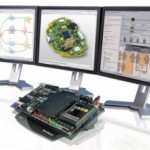 Whatever your needs, goals or problems that require an effective electronics design solution, having a team of designers with the right electronics experience is critical to the success of your project. Electronics design in electrical hardware and equipment can cover anything from individual components such as integrated circuits or printed circuit boards (PCBs) to communication interfaces or embedded systems.
Whatever your needs, goals or problems that require an effective electronics design solution, having a team of designers with the right electronics experience is critical to the success of your project. Electronics design in electrical hardware and equipment can cover anything from individual components such as integrated circuits or printed circuit boards (PCBs) to communication interfaces or embedded systems.
Whether your design project focuses on component creation, a simple complete piece of hardware or something more complex such as a high-speed digital custom RF, effective design prototyping is necessary to make sure the software and firmware integration is smooth and free of bugs and other issues the early stages. Cutting edge design software has helped this process considerably.
Highly Competitive Electronics Design
For any company built on a principle of pushing the boundaries of innovation, the electronic hardware design market is a great place to thrive. Because of how the industry moves forward, clients are seeking ever more complex PCBs and other components to make smaller, cheaper and faster-embedded systems.
The demands placed on PCBs especially (such as copper wire density) by the more complexly designed electronics have been matched by 3D modelling design software to make these feats possible. These programs continue to be pushed to the limits by electronic designers.
The physics modelling of such software is also becoming increasingly accurate, a fact which makes the prototyping phase even more cost-effective for clients while simultaneously allowing for greater creativity on the part of the designer.
In the past people designing PCBs relied on physical mockups to ensure the correct form and function but modern software is allowing digital re-creations to be made, more easily allowing for the stricter design parameters to be ‘tested’ prior to production. If a prototype or mockup circuit board failed to be fit for purpose, a ‘re-spin’ was necessary which wasted time and money.
Automated Electronics Design
Automated electronic design (or electronic design automation – EDA, as it’s more commonly known) represents a genre of software-based tools used by electronic designers who create systems such as PCBs, integrated circuits and other components.
For example, the modern integrated circuit has many millions of transistors, but several decades ago they contained considerably fewer. This meant that electronics designers could use mechanical drawings to draft out the design of the chip before it was fabricated as a hardware reality. As the fabrication process became more advanced and transistors shrank towards sizes measured in nanometers, it became a lot less feasible to draw out such intricate designs of electronic components using traditional drafting methods.
Even since around the 1970s, there have been some elements of automation around the electronic design process.
Combining Automation & Innovation
Electronic design experts these days use a combination of modern electronic design automation software and the kind of innovation that comes with a team of designers with many years’ experience with pushing the boundaries of what’s possible.
For the best results with EDA and other software to design electrical systems, a team of designers with a broad spectrum of electrical component experience woks well. That’s just one of the reasons why LX Group won the Electronic News 2012 Future Awards and many other prestigious electronics design awards.

 Custom electronics prototyping and designs are often needed when a company is making something innovative or that’s never been seen before. Off-the-shelf printed circuit boards, (PCBs) hardware communication controllers and many other electronic components can limit a company’s creativity when designing such a brand-new product from scratch.
Custom electronics prototyping and designs are often needed when a company is making something innovative or that’s never been seen before. Off-the-shelf printed circuit boards, (PCBs) hardware communication controllers and many other electronic components can limit a company’s creativity when designing such a brand-new product from scratch.